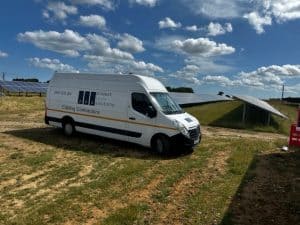Solar Farm Fibre Repair
The solar farm in Norfolk serves as an important source of renewable energy, providing electricity to the local community. It relies on a network of fibre optic cables to transmit data and facilitate communication between various components of the solar farm’s infrastructure. A fibre optic repair was required quickly to restore the farm’s vital data and communications infrastructure.
The Challenge:
Unfortunately, due to an accidental digging incident, a critical fibre optic cable was damaged, disrupting the efficient functioning of the solar farm. On site it was decided that the installation of a fibre joint and fusion splicing would be necessary to fix the problem.
Location challenges:
1) Environmental Challenges: the solar farm was located in a rural area surrounded by fields, with the fibre cable running under the expansive landscape. This meant that the repair had to be carried out in an open environment, subject to unpredictable weather conditions.
2) Environmental Considerations: potential environmental impacts would mean liaising with solar farm management to devise a plan that minimally disturbed the natural surroundings. Additionally, precautions would need to be taken to prevent any potential damage to the surrounding vegetation or farmland.
3) Unexpected Visitors: the presence of free-roaming sheep in the work space posed a challenge in terms of ensuring their safety and minimising disruptions to their grazing activities.
Infrastructure challenges:
4) Short Fibre Cable: after inspecting the site, it was realised that the fibre cable was shorter than first thought. There was not enough space within the duct to rod new cable, so this left no room for error when carrying out the repair.
The Solution:
The damaged section of the fibre optic cable required a fibre joint to be installed. This involved carefully connecting the two severed ends of the cable using fusion splicing techniques, ensuring minimal signal loss and maintaining the overall network integrity.
Addressing the challenges of the solar farm fibre cable repair
1) Environmental Challenges: Luckily, the weather was fair on the day. A parasol was enough to provide adequate protection from the sun. However, the measures that were put into place in the event of poor weather conditions in the open area were to erect temporary work tent to provide shelter from wind and rain.
2) Environmental Considerations: Working closely with the solar farm management protective measures were implemented to ensure the safety of the sheep during the repair process. Precautions were taken to prevent any potential damage to the surrounding vegetation or farmland.
3) Unexpected Visitors: Site personnel would meet us on arrival and remove sheep from the working area to ensure their safety and ours.
4) Short Fibre Cable: Fortunately, there was no need for new ducting to be installed for new cable and the repair was able to be successfully completed on the existing cable.
How the fibre cable repair was carried out
1) Fibre Joint Installation: The fibre optic engineer skilfully prepared the damaged ends of the cable for fusion splicing. Fusion splicing involves precisely aligning the two fibre ends and permanently joining them using a fibre splicing machine. A fibre joint box was used to contain the repair. This process guarantees a reliable and efficient connection with minimal signal loss.
2) Testing and Quality Assurance: Once the fibre joint was securely installed, the repaired fibre cables underwent comprehensive fibre testing to verify the success of the repair. Advanced optical testing equipment completed an OTDR test (Optical Time Domain Refraction Test) was used to measure signal strength, loss, and overall network performance. This ensured that the repair was effective and that the splicing was completed to our high standards, providing a seamless communication pathway. The repair restored the solar farm’s ability to monitor its performance and control of the output.
Solar Farm Fibre Repair: The Result
The repaired fibre cables underwent rigorous testing, which confirmed that the repair had resolved the issue and that the fusion splicing was effective, with no loss. By utilising fusion splicing techniques and rigorous testing procedures, we were able to restore the functionality of the solar farm’s fibre optic network, facilitating uninterrupted communication and data transmission.
Even in potentially challenging environmental conditions, our fibre optic engineer effectively addressed the unique circumstances of the solar farm in Norfolk. By having a diverse range of essential components readily available, PSS Installations can swiftly respond to various fibre optic repair scenarios, ensuring minimal downtime and efficient restoration of network connectivity.



